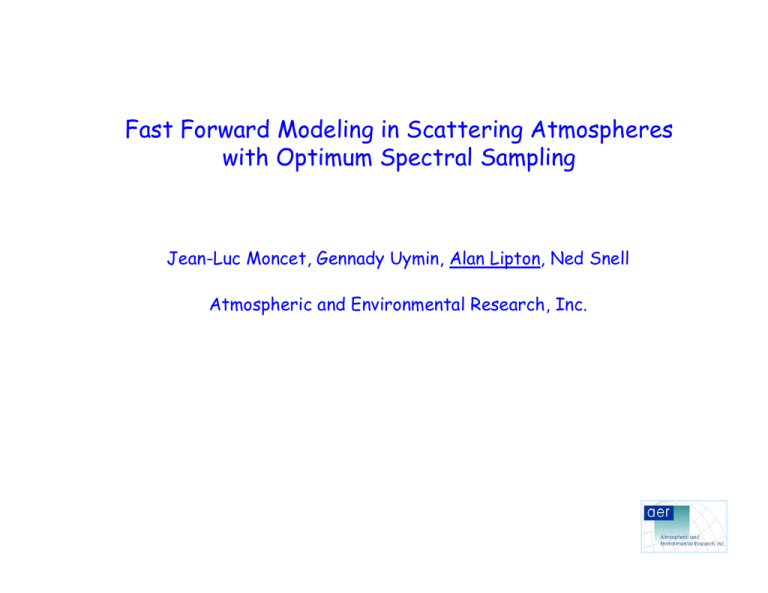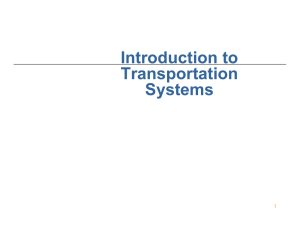Fast Forward Modeling in Scattering Atmospheres with Optimum Spectral Sampling
advertisement

Fast Forward Modeling in Scattering Atmospheres with Optimum Spectral Sampling Jean-Luc Moncet, Gennady Uymin, Alan Lipton, Ned Snell Atmospheric and Environmental Research, Inc. Topics Optimal Spectral Sampling brief overview Global training Application to AIRS and IASI Use of principal components of radiances Treatment of multiple scattering Current training method Minimizing the number of scattering RT operations Application to AIRS and MODIS -2- Review of the Basic OSS Method OSS channel radiances modeled as (Moncet et al. 2003, 2001, 2008) N R = ∫ φ (ν )R (ν )dν ≅ ∑ wi R (ν i ) ; ∆ν i =1 νi ∈ ∆ν Channel-average radiance is modeled as weighted average of monochromatic radiances Wavenumbers νi (nodes) and weights wi are optimally selected to fit calculations from a reference line-by-line model for a globally representative set of profiles (training set) Monochromatic absorption coefficients from look-up tables Demonstrated to be generally faster and more accurate than methods that use regression to fit the space-to-level band transmittance (here called total path transmittance regression = TPTR methods) For molecular absorption, non-scattering computations Scattering case is discussed in this presentation -3- Training Approaches: 1) Local Training Operates on individual channels, one at a time Nodes for each channel required to be within spectral range of channel response Nodes may be shared between channels with overlapping responses AIRS (2378 channels): Average: 11 nodes weighted per channel Average: 1.3 nodes/channel overall (accounts for sharing) -4- nodes weighted per channel nodes weighted, adjusted for sharing Training Approaches: 2) Global Training Operates on groups of channels (up to the full channel set) simultaneously Uses clustering of nodes to efficiently account for spectral correlations Condenses the information of the full channel set into a minimal number of nodes Monochromatic RT at a relatively few nodes determines radiances for full channel set Optionally, can be fit to channel subset, or first X principal components of channel set, or radiances filtered by PC transformation Reduces information relative to full channel set -5- AIRS Example # channels # nodes # nodes / # channels N' AIRS - full channel set Local* Global20 Global 2378 2378 2378 5340 2323 507 2.25 0.98 0.21 9.84 35.60 203.63 AIRS - 281 channel subset Local Global20 Global 281 281 281 1809 993 328 6.44 3.53 1.17 11.75 30.53 238.43 N’ = number of nodes contributing to radiance computation in 1 channel (on average) Training conditions: • 0.05 K accuracy requirement • Extra wide range of incidence angles (0°–70.5°)* • Variable gases H2O, O3 *difference from data in chart 4 Global20 Surface emissivity assumed linear over contiguous 20 cm-1 intervals (needs to be verified with real data) Global training applied independently to each interval Provides extra robustness by avoiding reliance on correlations from distant spectral points Extra robustness for surfaces whose emissivity spectra are outliers -6- Application to IASI Global and local training results Number of nodes Local Global Global nodes/ channels IASI band Spectral range (cm−1) Number of channels 1 645–1210 2261 1855 220 0.097 2 1210–2000 3160 2927 281 0.089 3 2000–2760 3040 2639 321 0.11 8461 7421 822 Total Training conditions: • 0.05 K accuracy requirement • 13 variable gases: H2O, O3, CO2, CO, CH4, N2O, F11, F12, CCl4, HNO3, SO2, OCS, CF4 • 5 fixed gases: O2, NO, NO2, NH3, N2 • Sources: ECMWF for H2O, O3; Global Modeling Initiative chem model for CO2, CO, CH4, N2O, F11, M. Matricardi for F12, CCl4, HNO3 • • 2002-2012 secular trends added for CO2 and CH4 Randomization was applied to all species for robust training • Emissivity spectra for global training is random walk, with 20-cm−1 steps -7- IASI Validation Validation with 48 independent UMBC profiles Each profile assigned 3 CO2 profiles: Minimum (●), mean (●), maximum (●) Validates robustness of training over CO2 trends -8- From local training OSS with Principal Components Option may be useful when some information loss is accepted as trade-off for speed When eigenvector truncation goes beyond eliminating redundancy Can be done without significant revision to OSS training Filter training-profile radiances with truncated eigenvectors Convert to PCs, then use reverse transformation to recover physical-space radiances OSS training achieves required accuracy for every channel (PC filtered) OSS coefficients project only on retained PCs (within training accuracy) Forward model output in terms of PCs efficiently done by combining eigenvectors with OSS coefficients in advance PC = U m R chan with m retained PCs R chan = W R node -9- PC = U m W R node = Wm R node where U m W ≡ Wm Scattering Forward Model OSSSCAT is single-wavelength version of CHARTS addingdoubling RTM Uses same molecular absorption and weighted monochromatic radiances as non-scattering RTM Cloud module converts from physical properties (e.g., IWP, LWP, Deff, top, thickness, T(p)) to optical properties (absorption and scattering optical depths, asymmetry parameter) Look-up table Size distributions based on in-situ aircraft measurements Mie for liquid MADA for ice – with temperature-dependent shape recipes Optical properties linearly interpolated from hinge points to OSS nodes - 10 - Cloudy Training Must include cloud/aerosol optical properties in training Over wide bands: training can be done by using a database of cloud/aerosol optical properties More general training obtained by breaking spectrum in intervals of the order of 10 cm-1 in width (impact of variations in cloud/aerosol properties on radiances is quasilinear) and by performing independent training for each interval Lower computational gain but increased robustnes Direct cloudy radiance training approach Clouds tend to mask molecular structure, which makes training less demanding If trained for mixture of clear and cloudy atmospheres in direct training, clear-sky performance degrades Train with clear-sky and several clouds simultaneously, requiring all to meet the accuracy criterion - 11 - Cloudy and Clear Fit OSS selection requires accuracy threshold be met for each training set individually and simultaneously AIRS Channel Set Scattering included Fit error -- all meet 0.05-K rms requirement Nadir view shown Clear - 12 - Liquid Clouds Ice Clouds Ice+Liquid Multiple Scattering Acceleration With scattering, execution time is dominated by radiative transfer integration Contrasts with non-scattering, where band transmittance calculation may be a bigger factor OSS RT timing ~proportional to number of nodes TPTR RT timing ~proportional to number of channels OSS is faster than TPTR methods only when the number of nodes / number of channels <~1 Scattering calculations do not have to be performed for each node Scattering correction may be predicted based on a few nodes only: [ N ] R ≅ ∑ wi R ns (ν i ) + ∑ Ck R(ν k ) − R ns (ν k ) i =1 k∈S R is radiance from scattering model Rns is radiance from non-scattering model w are the ordinary OSS weights k are a subset of the set of the OSS nodes (S) for the channel C are regression coefficients Number of predictors can be tuned to control balance between cloudy radiance accuracy and computation speed Some relaxation of accuracy may be tolerable in clouds with high optical depth, in proportion to uncertainties in optical properties - 13 - In thermal regime Scattering Prediction Performance for MODIS Bandpass (µm) Number of nodes* Number of predictor nodes† 20 3.660 - 3.840 10 4 21 3.929 - 3.989 5 2 22 3.929 - 3.989 3 2 24 4.433 - 4.498 19 2 25 4.482 - 4.549 18 2 27 6.535 - 6.895 14 1 28 7.175 - 7.475 15 2 29 8.400 - 8.700 14 3 31 10.780 - 11.280 4 1 32 11.770 - 12.270 4 1 33 13.185 - 13.485 18 1 34 13.485 - 13.785 21 1 35 13.785 - 14.085 24 1 36 14.085 - 14.385 21 1 13.6 1.7 MODIS Channel # Average - 14 - Selected IR channels Localized training used Generalized may require fewer predictors * for error threshold 0.05 K, clear and cloudy training † for scattering prediction error threshold 0.2 K Reference for Performance: TPTR Method for MODIS Simulated TPTR method Ideal case of no error in transmittance regression Effectively approximates reflected component as product of band-averages Rrefl ≈ r Τ R ↓ neglects in-band correlations biggest impact is with low emissivity = high reflectivity r - 15 - Channel 27 Ice cloud (nadir) Channel 28 Ice cloud (60°) Liquid cloud (nadir) Liquid cloud (60°) Channel 29 Desert (high reflectivity surface) OSS Performance for MODIS Accelerated with Scattering Selection Scattering: 2 predictor nodes 3 predictor nodes all nodes Channel 27 Ice cloud (nadir) Channel 28 Ice cloud (60°) Liquid cloud (nadir) Liquid cloud (60°) Channel 29 Desert (high reflectivity surface) - 16 - Generally 1-2 predictors are sufficient to exceed TPTR accuracy Summary Global training with correlated clustering minimizes number of nodes for channel set as a whole Flexibility – same monochromatic (physical, general) framework provides options to meet user requirements Produce radiances for full channel set Retrieve/assimilate at OSS nodes Avoids computational cost of mapping from nodes to channels Involves channel → node transformation of measurement error covariance Treatment of scene-dependent noise depends on application Scattering version maintains accuracy in clear areas Scattering can be accelerated with process to select subset of nodes to do scattering Requires testing with global training - 17 - Backup Inversion Variational retrieval methods: Average channel uses ~150 nodes Mapping Jacobians from node to channel space partially offsets speed gain Alternatives: (a) PC (reduces first dimension of matrix A) (b) Operate directly in node space y m = Ay%m → yˆ%m = Hy m Avoids Jacobian transformation altogether and reduce K-matrix size (inversion speed up) for AIRS: 2378 channels -> 250 nodes - 19 - δ xn +1 = ( K S K n + S T n -1 ε -1 x −1 )K T n ( ) Sε-1 yn - y m + K nδ xn , where, y = Ay%and % K = AK ( ) −1 ~ y m = A T S ε−1A AT S ε−1y m ~ Sε−1 = AT S ε−1A −1 ~ ~ ~ ~ ~ ~ δx n +1 = K Tn Sε−1K n + S −x1 K Tn Sε−1 (~y n − ~y m ) + K nδx n ( ) **Equivalent to [ ] δx n +1 = (K Tn S ε−1K n + S −x1 ) K Tn S ε−1 [(y n − AHy m ) + K nδx n ] −1 Inversion (continued) Retrieval performance – constant noise Need strategy for handling input dependent noise Scene temperature dependence (clear/cloudy) worse in SW band Cloud clearing noise amplification H-transformation not overly sensitive to noise For clear retrievals: sufficient to update noise covariance regionally Channel space retrieval Node space retrieval - 20 -




